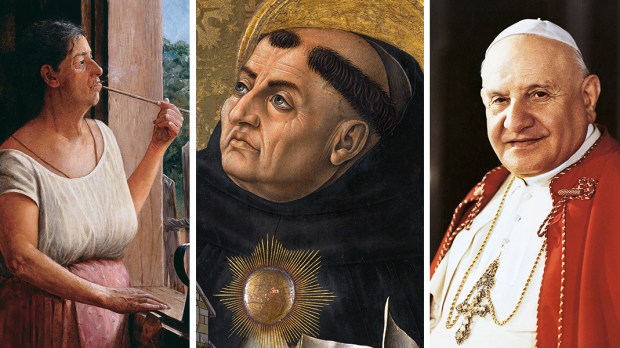As a new year dawns, voices surround us, whispering about all the things that are wrong with us, all the resolutions we ought to make, and (especially) all the diet and exercise plans we ought to bind ourselves to. But as our culture’s obsession with body size demands thinness of us again, it’s helpful to remember that it is not holier to be skinny.
One of the most fundamental teachings of Christianity is that our bodies are good — God himself decided to take on a body, and not just for a few years as he walked around earth. He ascended into Heaven with that resurrected body, and there, with a very human body, he sits at the right hand of the Father for evermore.
Bodies, as we know, come in all shapes and sizes; they are graced with all sorts of abilities and struggle with all sorts of disabilities. And they are all good.
Though the images of saints generally show them all as slender, we know that many weren’t. There have been plenty of heavier saints in recent years, which means there are even more from the more distant past whose size has been lost to history.
The communion of saints isn’t a million pretty skinny people with St. Thomas Aquinas sticking out like a sore thumb. The communion of saints is the trim and corpulent alike!
Whatever our size or disability or chronic illness, our bodies are good. Hating them does nothing to serve the kingdom or conform our hearts to Christ, as these larger-bodied saints remind us. Body size is not evidence of sinfulness or inadequacy or virtue or restraint. Holiness is not out of reach just because you don’t match the stained glass windows.
St. Olaf II (995-1030) is also known as St. Olaf the Fat. Olaf was the son of the king of Norway, a Viking pirate, and a convert to Christianity. When he became king, he brought missionaries to Norway but was forced into exile by a people who were uninterested in converting. King Olaf returned with an army and died in battle. He’s considered a martyr because he was killed for his attempts to evangelize his people.
Bl. Isnard de Chiampo (d. 1244) was one of the first Dominican friars, a man whose life of extreme asceticism did nothing to reduce the size of his body. A talented preacher, he would often endure ridicule while preaching as people taunted him for his size (demonstrating that fatphobia is no modern invention). But Fr. Isnard’s virtue was well known and he remained successful as a Dominican prior and preacher against heresies.
St. Thomas Aquinas (1225-1274) is the most famous of the fat saints. Known as the dumb ox for his customary ponderous silence and his girth, Thomas ran from the prestigious Benedictine vocation arranged by his family to become one of the Dominican Order’s greatest thinkers of all time. Contemporary accounts call him “large and heavy” and “very fat,” though the story that he had a hole cut out of the table to fit his belly may be purely legendary. What a mercy for the entire Church that Thomas was unconcerned with anyone’s opinions, and spent his time in prayer and study rather than spending his life pursuing thinness.
Bl. Francisca de Paula de Jesus (1810-1895) was born into slavery in Brazil but freed at age 10. She became a philanthropist, funded only by her begging, and one of the most respected voices of wisdom in the region, though she never learned to read.
Bl. Mary of the Passion de Chappotin (1839-1904) was the French foundress of the Missionary Sisters of Mary. She endured much suspicion and opposition in her religious life, from within her new order and without, but persevered in her leadership of a women’s order dedicated to missionary work.
St. Rafael Guizar y Valencia (1878-1938) was an undercover priest in Mexico during the Mexican Revolution and later a bishop so brave that when he heard the governor had put a price on his head, he marched across town to tell the governor to man up and kill him himself. Impressed (and possibly intimidated), the governor made his peace with the bishop.
St. Laura Montoya (1874-1949) spent her childhood feeling abandoned and unloved in Colombia. She went on to found a religious order to serve the despised Native people who lived in the Colombian wilderness, despite much opposition from racists in the Church as well as those who thought women had no business working in mission fields.
St. John XXIII (1881-1963) was raised in poverty and worked as the apostolic Delegate to Turkey before being elected pope. Shortly after his election, he overheard a woman saying, “My God, he’s so fat!” Good Pope John calmly replied, “Madame, the holy conclave isn’t exactly a beauty contest!” Pope John was famous for his sense of humor and his kindness. Though he was expected to be a placeholder pope, he surprised the world by opening the Second Vatican Council.
Servant of God Catherine Doherty (1896-1985) was a Russian aristocrat who fled the Revolution to Canada, divorced her abusive husband, obtained an annulment, raised her son as a single mother, remarried, and founded a movement of people living in voluntary poverty and serving the poor.

Read more:
Saints who struggled with addiction

